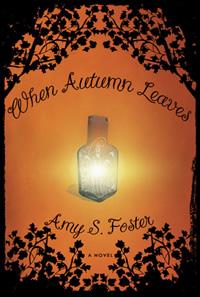Isle of Dreams
With her magical first novel, songwriter Amy Foster has another hit on her hands
In Amy S. Foster’s debut novel, When Autumn Leaves, a female healer catches lightning in a bottle because the island town of Avening in the Pacific Northwest is a place where events defy logical explanation. The novel, like its setting, is a cozy one. The citizens of Avening, who long ago grew “to accept the bizarre anomalies as normal,” always have a warm cup of peppermint tea at the ready for a visiting neighbor or friend. This is a book about the miraculous, the magical, and the vibrantly hopeful, and its charm lingers long after the book is closed.
 When Autumn Leaves introduces Autumn Avening, a sister in the mystical and ancient all-female order of the Jaen (a sisterhood whose provenance and responsibilities are not explained until novel’s end). Autumn is said to be a descendant of the town’s founder and owns a store called Demeter’s Grove that’s down the street from the local coffee shop, Hallowed Grounds, and the bookstore, Totems. At Demeter’s Grove, Autumn sells a little bit of everything—”new age” books, elemental stones, clothing—and she is always “inviting all kinds of strangers and friends into her kitchen” for everything from an informal chat to demonstrations on “cooking, baking, tincture and poultice making.” For the town of Avening, she’s more than a dear friend, counselor, and wise confidant; she—and her ancestors—are why Avening has always been known as “a haven and a refuge from so many of the troubles that circle other small towns and circle over the concrete sorrows of big cities.”
When Autumn Leaves introduces Autumn Avening, a sister in the mystical and ancient all-female order of the Jaen (a sisterhood whose provenance and responsibilities are not explained until novel’s end). Autumn is said to be a descendant of the town’s founder and owns a store called Demeter’s Grove that’s down the street from the local coffee shop, Hallowed Grounds, and the bookstore, Totems. At Demeter’s Grove, Autumn sells a little bit of everything—”new age” books, elemental stones, clothing—and she is always “inviting all kinds of strangers and friends into her kitchen” for everything from an informal chat to demonstrations on “cooking, baking, tincture and poultice making.” For the town of Avening, she’s more than a dear friend, counselor, and wise confidant; she—and her ancestors—are why Avening has always been known as “a haven and a refuge from so many of the troubles that circle other small towns and circle over the concrete sorrows of big cities.”
Fear not the many references to incense, candles, and “earth energy” in this book. The success of the book’s magical realism lies in Foster’s ability to balance the day-to-day rhythms of small-town life against the fantastic elements of the story. Avening may celebrate December 21st with a town-wide Solstice Lighting, but no one’s pushing crystals and broomsticks on young children. Avening observes the pagan holiday calendar because “these holidays center around the seasons, the harvest, night and day, tangible things that people could see and count on, a common thread that united them all. Not everyone may believe in the same thing, but everyone can believe that even the darkest, coldest winter will move over and make room for spring. And so they all celebrate together, and it’s enough to create the shared community that a town needs to thrive and bustle.” And Avening does thrive: “The town buzzed and hummed and purred. It felt alive.”
 The residents of Avening are a beguiling mix of the eccentric and the everyday. Autumn discovers this truth for herself when she learns from the Jaen oracle that it is time for her to leave the town. Provided with a list of local women and told to choose her successor, she doubts she can find an individual capable and skilled enough for the job. The women range from earth mothers to elementary school teachers, and each is possessed of a special gift, though none fully recognizes her own potential.
The residents of Avening are a beguiling mix of the eccentric and the everyday. Autumn discovers this truth for herself when she learns from the Jaen oracle that it is time for her to leave the town. Provided with a list of local women and told to choose her successor, she doubts she can find an individual capable and skilled enough for the job. The women range from earth mothers to elementary school teachers, and each is possessed of a special gift, though none fully recognizes her own potential.
Several of the candidates Autumn has never met, while others look to her like anything but leaders. So she places a notice in the Avening Circle, advertising for an apprentice and inviting applicants to write an essay. As the paths of Autumn and these women cross, the mysteries of When Autumn Leaves—Who are the Jaen? Is Autumn a witch? Where is she going after Avening?—begin to resolve. Even Autumn comes to understand that there’s “much more to her, more for her, than she had allowed herself to believe.”
Foster is a successful Nashville songwriter—Josh Groban, Michael Bublé, Diana Krall, and Destiny’s Child have all recorded her songs, and she has hit the number-one slot three times so far—but when it comes to prose, Foster’s talents as a storyteller stand on their own: her style is comfortably straightforward, and she navigates with ease a multi-layered and well-paced plot. The worth of When Autumn Leaves doesn’t need to be qualified. It isn’t just good for a first book by a songwriter; it’s a truly enchanting read.


